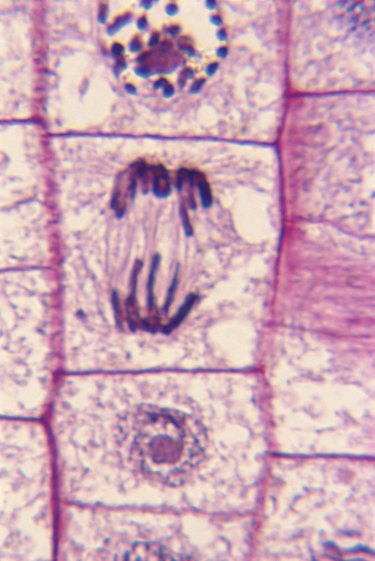Things You'll Need
Poster board
Colored construction paper
Scissors
Glue
Crayons, markers or colored pencils

Organelles are the various parts inside of an animal or plant cell, each which have specialized functions. The main organelles in an animal cell include the cell membrane, nucleus, nucleolus, cytoplasm, Golgi complex, endoplasmic reticulum, lysosomes, ribosomes, vesicles and mitochondria. Plant cells contain additional organelles, including the cell wall, vacuoles and chloroplasts, but do not contain lysosomes. With some poster board and construction paper, you can quickly create a crowd-pleasing organelle model containing all of these important parts.
The Cell
Step 1

Draw a large circle, just left of the center of your poster board, to represent your animal cell; draw a large hexagon just right of the center of your poster board, to represent your plant cell.
Video of the Day
Step 2
Title your poster board. "Cell Organelles" is one example of a fitting title.
Step 3
Label the circle "Animal Cell" and the hexagon "Plant Cell."
Step 4
Label the lines around your two cells "cell membrane." This membrane helps protect the cells, by controlling the movement of materials in and out of the cell.
Step 5
Draw a line pointing at part of the blank space inside of each cell, and label this blank space, "cytoplasm." Cytoplasm is the nutrient-rich liquid the organelles float around in, and are represent by the space between organelles in your model.
The Nuclear Organelles
Step 1
Select a piece of colored construction paper and cut out a circle about one-fourth, or 25 percent, the size of your animal cell. Glue it inside of the cell, just off-center. Repeat the process for the plant cell. These circles can be labeled "nucleus," and represent the control center or brain of your cells.
Step 2
From another, different-colored piece of construction paper, cut out a circle about one-fourth, or 25 percent, the size of your nucleus. Glue it inside of your animal cell's nucleus. Do the same for your plant's nucleus. These can be labeled "nucleolus," and produce ribosomes.
Step 3
Label the edge of the circle around each nucleus "nuclear membrane." Like the cell membrane, it controls what goes into and what comes out of the nucleus.
Step 4
Draw four or five squiggly lines, close together, around about half of the your nucleus of both cells. Color them in with crayon or marker, then make different-colored dots inside the lines. These can be labeled "endoplasmic reticulum," which is where proteins are processed.
Non-nuclear Organelles
Video of the Day
Step 1
Cut out two 4- to-8-inch-long football-shaped pieces from colored construction paper. Glue these somewhat close together inside your animal cell, and draw a few folds or lines inside them. Repeat this step for your plant cell. These can be labeled "mitochrondia," and are the cell's power plants, responsible for transforming food into energy.
Step 2
Cut out four strips of paper, each strip about as wide as your finger, and glue them close together somewhere inside your animal cell. Do the same thing in your plant cell. These can be labeled "Golgi complex," which processes, sorts and ships proteins for the cell.
Step 3
Draw five or six small, coin-sized circles around the Golgi complex and endoplasmic reticulum, for each cell. Color them in. These can be labeled "vesicles," and are responsible for transporting proteins and other material around the cell.
Step 4
With a crayon or marker, draw 12 to 24 dots inside the blank spaces of both cells. Label these dots "ribosomes," which are the workbenches of protein creation.
Step 5
For the animal cell only, cut out five-or-six tiny semicircles from colored construction paper. Glue these evenly throughout the animal cell's blank spaces, and label them "lysosomes." These clean up the cell by digesting foreign material and the waste products of the other organelles.
Plant Cell Organelles
Step 1
Draw small boxes all the way around your plant cell's cell membrane. Label these boxes "cell wall." The rigid cell wall exists to support and protect the cell, providing structural strength and allowing plants to grow tall.
Step 2
Cut out five-or-six small circles from green construction paper. Glue these circles evenly throughout the plant cell, and label them "chloroplasts." Chloroplasts allow plants to photosynthesize sunlight, and give them their green color.
Step 3
Cut a large, blob-like shape out of blue construction paper, and fill as much blank space inside your plant cell as you can with them, without cutting them or making more. Label it "central vacuole." This watery blob contains the plant cell's water and nutrients.
Tip
In his book, "Biology: A Guide to the Natural World," David Krogh compares the cell to a factory, where the cell membrane is the security gate, the nucleus is the control center, the endoplasmic reticulum is the assembly line, the Golgi complex is the distribution center, ribosomes are the workbenches, mitochondria are the powerhouses, and lysosomes are the cleaning crew. The organelle model in this article can be reworked in this and similar ways, with only a little effort, for younger audiences and novel presentations.